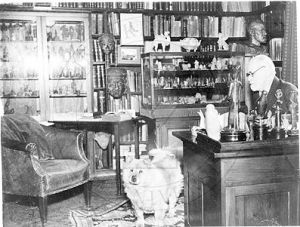In the next chapter of Eight Theories of Religion, Pals considers Karl Marx’s analysis of religion. Marx’s influence is, of course, enormous in the nineteenth and twentieth centuries. He is best known for his theory of history (historical materialism) and for providing a total system of thought (that curiously resembles a religion in its own way, with its sacred readings, heroes, need to convert others, etc). However, his focus was on how society changed over time and Marx never wrote a thorough account of religion. Rather his analysis of religion was a token element in his larger analysis of economic and material life.
He had rejected religion early in his life. As an atheist, he believed religion to be an invention of humanity. “Man makes religion, religion does not make man,” he declared.[1] Religion is treated in two different ways, as either the tool of the ruling class or the expression of the suffering masses. This is a functional theory of religion. Marx is not interested in religious content but the roles these beliefs play in social struggle, we discover the key to religion only when we discover what role religion plays socially or psychologically.
His ideas of religion were greatly influenced by the philosopher Hegel. Marx was born in 1818 in Trier, part of the Prussian Rhineland of the time (modern Germany now). Thus, he studied at the University of Berlin, which had been dominated by the ideas of Hegel and played a central role in Marx’s thought. Hegel held that mind/consciousness was more fundamental than matter. Material things and reality were the expression of an underlying universal consciousness that progressed through a dialectic. As our consciousness changed and progressed through the process of overcoming inherent problems, humanity shaped and changed material reality. Marx reverses this insight and says that matter comes before mind–the shape of ideas and culture are a product of material reality.
The most fundamental part of human life is our interaction with the material forces of reality. Economic reality shapes and informs culture and society, which is a struggle over scarce goods. As one group gained an advantage over another, history became a class struggle, a perpetual dialectic among the socials classes between those who own the means of production and those who must work. The economic base produces the various forms of the division of labor, the struggle of the classes, and human alienation. Those aspects that are impacted by the base belong to the superstructure, such as laws, culture, and the arts. Our cultural and intellectual life is a reflection of our economic organization.
The institutions of human life such as family, government, the arts, philosophy, ethics, and religion are developed to control and maintain the deep tensions that emerge from internal contradictions within the social structure and also between the social structure and the economic base. The production of artists, politicians, and theologians creates “ideology”, i.e. a systematic defense of the present state of affairs. In reality, they are the expression of class interests that defend the system of privileges.
Religion is an ideology and a product of the tensions between the base and the superstructure. It is a belief system that provides reasons to maintain the status quo in favor of the ruling class. Thus, belief in God or gods is a by-product of the class struggle and an illusion that is detrimental to social health. Further, religion is the expression of an “inverted world” where the pain of humanity seeks solace in another source because it cannot find amelioration in its material conditions. Marx says in one of his many immortal phrases, “Religious suffering is the expression of real suffering, religion is the sigh of the oppressed creature, the heart of the heartless world, as it is the spirit of spiritless conditions. It is the opium of the people.”[2]
Consequently, the social effect of Religion is social pacification. It is a mystification that keeps people from seeing the truth of reality. Marx’s view of religion was significantly influenced by the work of Ludwig Feuerbach. In 1841, Feuerbach published his book The Essence of Christianity, a philosophical attack on Christianity that blamed it for alienating human consciousness. Feuerbach argues that Christian theology proposes an alien being that possesses our most highly held personal qualities such as “goodness, beauty, truthfulness, wisdom, love steadfastness, and strength of character and project them onto God” (Pals). Rather than attribute these qualities to ourselves, they are attributed to a God. In reality, the subject of theology is humanity. In looking for heaven, humanity found a reflection of itself.
Marx accepted Feuerbach’s critique, seeing religion as a mystification that alienated humanity from the truth of its condition. Religion is just the expression of the greater distress of the economic and material alienation of humanity. Marx did not blame the problems of society on religion. The problem is not state religion but the mystifications that hide the causes of inequality and suffering. Religion is the mere surface problem because the true problem is social injustice.
[1] Marx, “Toward A Critique of Hegel’s Philosophy of Right: Introduction,” Selected Writings, 28.
[2] Karl Marx, “Toward A Critique of Hegel’s Philosophy of Right: Introduction,” Selected Writings, 28.






